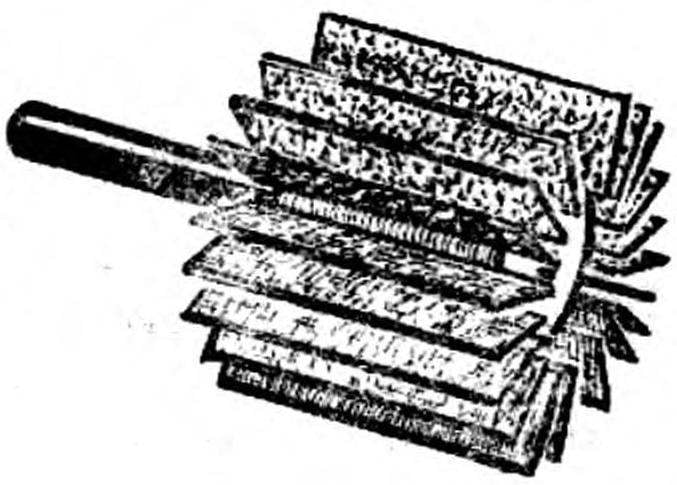To mechanize this work at home is easy with an electric drill or a drill, securing the cartridge in the appropriate abrasive. But just needs that sometimes at hand is not provided. However, the most common can be made with your own hands.
For grinding small products Pasto simply abrasive cloth wound on a metal tool holder. The skin does not rotate, one edge is fixed in the special slots. Wound on the rod perform in a variety of ways, getting the tool of one form or another. In some cases it is advisable to use rods with an annular ledge: it prevents the slipping of the sheet during operation.
From scrap materials and some wastes can produce and abrasive heads of different shapes intended for the processing and finishing of shaped surfaces. Molded heads are made of abrasive powder of the pulverized waste accumulating under the grinding devices. They should be carefully rinsed to remove too small particles and dust from processed materials. Extracted the iron filings with a magnet wrapped in a plastic bag: from time to time the magnet is removed, and the adhered sawdust on the package wash off with water.
Fig. 1. Grinding of the skin and the mandrel to them
Fig. 2. Solid abrasive heads and their landing on the mandrel.
Fig. 3. Disc abrasive from the sandpaper.
Fig. 4. Brush from the skin.
The finished powder is dried and sieved through a fine metal mesh. Then the abrasive is mixed with a binder — epoxy or silicate (office) glue. The resulting mass is brought to a complete wetting. The mixture is stuffed into a prepared form, similar in configuration to the workpiece. Material for forms and will serve as a paper Cup, and a pound of plastic film or foil, and tube made of cardboard impregnated with paraffin. In replying to their abrasive mass is extruded in the recess or the through hole under a metal foot for mounting in the Chuck. Such holder is pasted on the epoxy, and may zapressovyvajutsja in the mass during molding. If finished, the working head has no alignment with a leg, it should be turned during the rotation of the coarse abrasive.
For sharpening the cutting disk cutters, saw chains, require thin disks, which would enter between the teeth. They are easy to obtain, glue reverse sides of two of emery sheet abrasives on a fabric base. Better to do it on epoxy glue: it will impregnate the fabric and further strengthens the grain. At the time of curing of the resin package is placed under a flat heavy object.
This disc is not suitable for cutting narrow grooves in hard materials — need and other, with grains not only the sides but also inside. This tool also can do it yourself.
For example, the disc thickness of one millimeter get, soaked in epoxy, four layers of gauze, each of which through the metal mesh screened abrasive powder. After making such a “sandwich” it .placed between sheets of polyethylene (will not stick to it epoxy) and allowed to stand under load to cure the resin. If necessary, can also be coated with abrasive and the outer plane of the disk. The final Form is given to the snips. Ready wheels is fixed PA special metal mandrels or ordinary bolt with a severed head — with the nuts and washers of large diameter.
Fig. 5. Detachable brush:
1 — nut. 2 — washer, 3 — rubber cylinder. 4 — skin 5 — metal body-glass.
Fig. 6. A method of manufacturing glass.
Fig. 7. Polishing wheels made of cloth.
For final high-quality or decorative sanding fabricate a rotating abrasive brush. First machined cylindrical base (beech, oak), it bore holes under the leg and parallel cuts, which stick smeared with PVA glue strips of abrasive cloth. If such work has to be carried often, the basis is to carve out of metal (aluminum) in the form of glass cuts, it is placed in the rubber cylinder with the same cuts, in which are inserted the petals of skin. Remains throw on axial rod with thread washer and nut; tighten the rubber cylinder stavitsa, firmly capturing the petals. When the diameter of Cup 35mm, you can install 16 petals.
After fine grinding is sometimes necessary to Polish the product. Of course, there is indispensable a felt circle. However, the fit and trim of cotton or wool fabric, stitched in 6-8 layers. Such blanks are placed on the rod of the mandrel to obtain the desired total thickness.
N. STARLINGS
Recommend to read BOARD ROOM “WEEDING” It is now customary to control weeds on the beds without chemicals. Weed or often just cover the beds by the opaque material beneath the weeds do not develop, and the seedlings planted... STEEL — DEAD All good new baths, stamped from sheet steel. But because of its light weight, unlike traditional cast iron, they are very fragile. This deficiency could be corrected by securing the tub...  Product handling abrasive tool (grinding) in most cases is finishing and finishing operation, ensuring high-purity and surface quality. Use it for rough work — cleaning workpieces from scale, removal of scallops on castings, smoothing welded joints, and for sharpening all kinds of cutting tools.
Product handling abrasive tool (grinding) in most cases is finishing and finishing operation, ensuring high-purity and surface quality. Use it for rough work — cleaning workpieces from scale, removal of scallops on castings, smoothing welded joints, and for sharpening all kinds of cutting tools.
